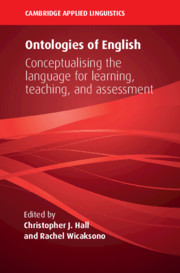Book contents
- Ontologies of English
- The Cambridge Applied Linguistics Series
- Ontologies of English
- Copyright page
- Dedication
- Contents
- Figures
- Tables
- Contributors
- Series Editors’ Preface
- Acknowledgements
- Transcription Conventions
- Part I Introduction
- Part II English in/for L2 Learning and Teaching
- Part III English in Schools
- Part IV Assessing English
- Part V English in Lingua Franca Contexts
- Part VI English and Social Practice
- Part VII Commentary and Conclusions
- 18 Pushing the Ontological Boundaries of English
- 19 Using Ontologies of English
- Index
- References
19 - Using Ontologies of English
from Part VII - Commentary and Conclusions
Published online by Cambridge University Press: 24 December 2019
- Ontologies of English
- The Cambridge Applied Linguistics Series
- Ontologies of English
- Copyright page
- Dedication
- Contents
- Figures
- Tables
- Contributors
- Series Editors’ Preface
- Acknowledgements
- Transcription Conventions
- Part I Introduction
- Part II English in/for L2 Learning and Teaching
- Part III English in Schools
- Part IV Assessing English
- Part V English in Lingua Franca Contexts
- Part VI English and Social Practice
- Part VII Commentary and Conclusions
- 18 Pushing the Ontological Boundaries of English
- 19 Using Ontologies of English
- Index
- References
Summary
In our introductory chapter, we argued that applied linguistics must be more explicit about the ways in which English is conceptualised in and for the domains of language learning, teaching, and assessment. Now, after eighteen chapters that uncover, advocate, and contest beliefs about the nature of ‘English’ in a range of contexts and from a range of perspectives, we take stock of the project and consider its uses. We don’t have the space here to reference all the arguments and evidence put forward by the authors of these chapters, but we will emphasise those points that we feel have helped to meet the aims of the book. Naturally, we give particular consideration to Pennycook’s companion commentary in the previous chapter.
Keywords
- Type
- Chapter
- Information
- Ontologies of EnglishConceptualising the Language for Learning, Teaching, and Assessment, pp. 368 - 376Publisher: Cambridge University PressPrint publication year: 2020
References
- 3
- Cited by

